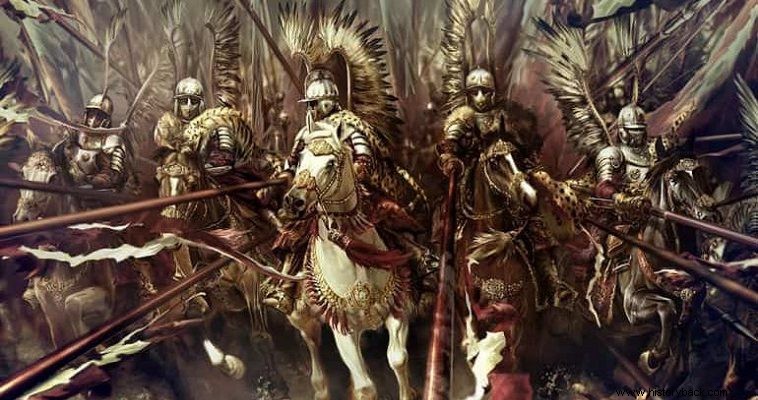
Polish winged hussars trace their "origin" to Serbian and Hungarian hussars of the late Middle Ages. But in contrast to them, the Polish hussars were heavy shock cavalry. The oldest reference to the winged hussars is from 1500. However, it is believed that their units had been formed earlier.
Officially, the first hussar units were created in 1503 by a decision of the Polish parliament. The units in question were composed of Hungarian mercenaries. Soon, however, purely Polish units were created. The sources refer to their action in the victorious battle of Orsha, in 1514, against the Russians and in the also victorious battle of Obertin against the Moldavians.
The hussar units included nobles and their followers. The organization was by "companies") formed by a noble with his followers, something similar to the "spears" of medieval knights. A number of ulama constituted an ili.
The "company" of hussars could consist of two to five fighting men, their horsemen, farriers and other craftsmen. The "company" was also called "kopia" from the name of the long spear that was their main weapon. The ili, known as "flag", because it had its own flag, (according to the Byzantines) consisted of 30-60 "kopia" numbering 60-300 combatants. One of the "kopia" was the hilarchu's personal subunit and was usually numerically larger.
The hussars were shock cavalry. Armed with a 5m long lance, long straight and shorter curved swords, war hammer, or sledgehammer, pistols and sometimes a short-barreled front-loading carbine, they charge at their opponents, like medieval knights, with the aim of literally sweeping them from the field. battle.
Their horses were strong and fast, specially bred, and could attack directly even after marching for many kilometers carrying their heavily armored and armed rider. Selling a hussar horse was punishable by death.
When Stepan Bathory became king of Poland and Lithuania in 1576, he included the hussars in his royal guard. Hussars also acquired their famous "wings". Each placed on the back of his chest a simple or double wooden frame on which he placed eagles, swans and even ostrich feathers.
During the attack the wooden frames hit the chests causing a loud noise. For the enemies this was, more often than not, the harbinger of death.
Each noble paid at his own expense for his own equipment and that of his followers. Only the lance, symbolically, was offered from the royal treasury. This lance had an average length of 5 m. However, there were also specimens over 6 m long. They were made of fir wood and had a hand guard. Later, shorter lances of 3-3.5 m were adopted. The long straight sword of the hussars was about 1.5 m long.
The armor consisted of iron plates reminiscent of the lorica segmentata of the Romans. However, western-style armor was also used. The helmets were of the lobsrter type with a katachen and face protection quorum. The weight of the armor reached 15 to 20 kg. In the 15th and early 16th th century the hussars wore chain breastplates.
The hussars wrote their own golden pages of glory on the battlefields against all the opponents of the Polish crown, crushing Germans, Swedes, Russians, Cossacks, Ukrainians and of course the Turks. Their contribution to the salvation of Vienna, in 1683, was more than catalytic.
